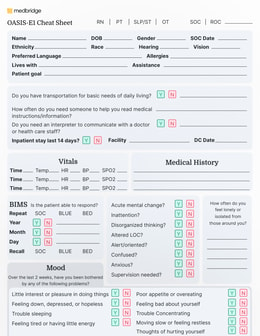PDGM: What Healthcare Leaders Need to Know
Stay current with PDGM updates and trends. See how Medicare data is reshaping home health strategy, coding behavior, and documentation workflows.
April 14, 2025
6 min. read

The Patient Driven Groupings Model (PDGM), implemented by CMS on January 1, 2020, marked a historic shift in how Medicare reimburses home health services. Designed to improve payment accuracy and reduce incentives for volume-based care, PDGM replaced the long-standing Prospective Payment System (PPS), introducing a case-mix adjusted 30-day payment period, new clinical groupings, and a renewed emphasis on patient characteristics over therapy volume.
Five years later, healthcare leaders are still navigating the full implications of this change—especially in a post-pandemic landscape where data collection, patient acuity, and agency behavior have all evolved. This article provides an updated overview of PDGM, examines key trends in coding and utilization, and outlines strategic considerations for home health organizations in 2025.
What Is PDGM?
PDGM is Medicare’s current payment model for home health services. It restructures reimbursement based on:
Patient diagnosis (ICD-10 code) for clinical group assignment
Functional impairment level
Comorbidity adjustments
Admission source and timing
30-day payment units (replacing the former 60-day episodes)
Therapy thresholds, which previously influenced payment under PPS, have been removed. Instead, PDGM is built around patient condition and complexity, aiming to better reflect resource needs.
The Impact of COVID-19 on PDGM Behavior and Trends
When PDGM went into effect in January 2020, few anticipated the global disruption that would follow. The COVID-19 pandemic changed care delivery, staffing, documentation workflows, and patient needs almost overnight.
While CMS made minimal regulatory updates in 2021, it continued collecting OASIS data, claims submissions, and utilization patterns throughout the pandemic. These data sets are now driving how CMS evaluates agency performance under PDGM—and may influence future rulemaking.
Key Takeaway for Agencies:
Even during regulatory waivers and pandemic flexibility, CMS was tracking coding trends, care utilization, and assessment behavior. This underscores the importance of maintaining clinically driven—not payment-driven—decision-making practices.
Coding and Comorbidity Shifts Under PDGM
ICD-10 Clinical Grouping Trends
During the early PDGM years (2020–2022), CMS observed a significant rise in Medication Management, Teaching, and Assessment (MMTA) – Respiratory clinical groupings. While this surge aligned with pandemic-related respiratory conditions, other trends—like the drop in MMTA – Endocrine—may reflect shifts in coding strategy or case mix.
What to Monitor:
Are your ICD-10 codes accurately reflecting patient needs?
Are coding practices consistent with documentation and clinical presentation?
Accurate clinical grouping not only supports appropriate reimbursement but also ensures data integrity and compliance in the event of audit or medical review.
Comorbidity Adjustment Trends
PDGM introduced low, medium, and high comorbidity adjustment categories—each influencing payment. Since 2020, the proportion of 30-day periods with high comorbidity adjustments has increased, raising questions about potential upcoding or changes in documentation behavior.
Why This Matters:
Higher comorbidity adjustments mean higher payments. Agencies must ensure diagnoses supporting these adjustments are well-documented and clinically supported—not simply added to enhance reimbursement.
Functional Impairment Levels and Therapy Utilization
Functional Impairment
Functional status—now assessed using OASIS-E1—remains a major driver in PDGM reimbursement. CMS data shows a notable shift toward high functional impairment designations since PDGM's implementation. While this may reflect increased patient acuity during and after the pandemic, it also raises questions about documentation accuracy.
Action Step:
Audit OASIS-E1 scoring patterns. Ensure your clinical teams are scoring functional items based on observable, documented evidence—not assumptions or payment considerations.
OASIS-E1 Cheat Sheet PDF
Submit a few brief details to unlock your free OASIS-E1 Cheat Sheet download!

Utilization Patterns and Therapy Services
PDGM removed the therapy volume payment thresholds that were central to PPS. Since then, therapy utilization has dropped significantly, especially in physical therapy and occupational therapy.
While lower therapy volumes were expected due to COVID-19-related access limitations, the combination of reduced visits and increased impairment levels suggests potential disconnects in care planning.
What to Ask:
Are therapy services aligned with patient needs?
Are care plans updated as functional status evolves?
Are changes in utilization driven by clinical need—or payment structures?
Opportunities for Agencies Under PDGM in 2025
PDGM is not just a challenge—it's a strategic opportunity. Agencies that embrace data transparency, clinical integrity, and operational efficiency can thrive under this model. Here’s how:
1. Strengthen Clinical-Coding Alignment
Invest in coder-clinician collaboration to ensure diagnosis coding reflects clinical documentation.
Train staff on ICD-10 specificity and PDGM clinical groupings.
2. Monitor Functional Assessments
Use quality audits to identify trends in OASIS scoring.
Provide training on accurate assessment without over- or under-estimating patient impairment.
3. Use Data to Guide Care
Track case-mix weight changes over time.
Analyze therapy utilization in the context of patient outcomes, not just compliance.
4. Stay Ahead of CMS Updates
Monitor annual proposed rules and final rule changes from CMS.
Prepare for potential changes to behavioral assumptions, wage index updates, or future refinements to the PDGM structure.
Looking Ahead: PDGM in a Value-Based Care World
CMS finalized key updates to PDGM as part of the CY 2025 Home Health PPS Final Rule, including a permanent -1.95% behavioral adjustment to the 30-day payment rate. This reduction, totaling approximately $280 million in decreased aggregate spending, reflects the agency’s assessment that actual provider behavior continues to differ from original PDGM assumptions¹.
CMS also finalized annual recalibration of case-mix weights and LUPA thresholds, as well as updates to the wage index and a continuation of temporary add-on payments for certain rural areas¹. These updates impact how agencies are paid for care and emphasize the need for accurate documentation, coding, and OASIS scoring.
“CMS is finalizing a permanent prospective payment adjustment to account for differences between assumed and actual behavior change on estimated aggregate expenditures under the HH PPS. The final permanent adjustment is a reduction of -1.951%.” ¹
Action Step for 2025:
Review how your agency's functional impairment scoring and comorbidity coding align with actual care delivered. Be prepared to adjust staffing models or documentation practices in response to shifting payment incentives and updated CMS benchmarks.
Final Thoughts
PDGM remains a transformative model for the home health industry. As we move into 2025, successful agencies will be those that embrace a data-informed, clinically grounded approach. Coding, assessment, and care planning must remain focused on patient need—not payment incentives.
At Medbridge, we provide the clinical education, documentation tools, and analytics support to help organizations adapt to PDGM while strengthening care quality.
Explore our home health software solutions to support better documentation, staff training, and data visibility—so you can optimize outcomes and thrive under PDGM.






